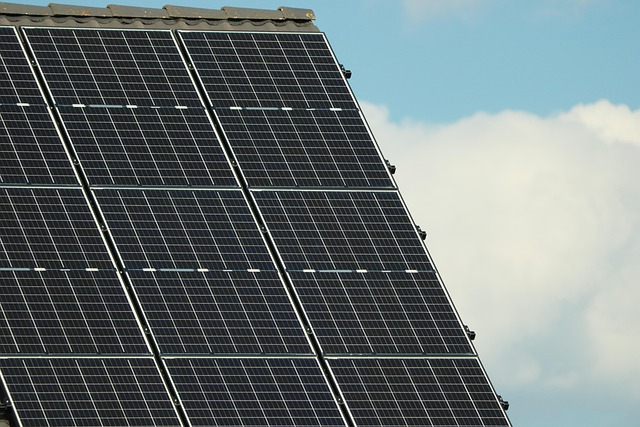Solar panels transform warehouse roofs into powerful energy hubs, cutting electricity costs and shrinking carbon footprints. By harnessing abundant roof space and high energy demands, businesses can achieve impressive savings and quick returns on investment. This approach not only boosts operational efficiency but also supports environmental sustainability, making solar a smart choice for modern warehouses seeking long-term value and resilience.
Maximizing Efficiency and Reducing Costs with Solar Panels on Warehouses
By leveraging Solar Panel Installation for Warehouses, businesses can rapidly transform energy expenses into substantial savings. Large, underused warehouse rooftops are especially suited for commercial solar photovoltaic systems, turning idle space into a reliable source of clean power. These systems reduce operating costs, which may account for up to 15% of warehouse expenditures, particularly for facilities reliant on lighting, refrigeration, or climate control.
In the same genre : Is it Possible to Upgrade Your 2012 Honda Accord with a Power Adjustable Driver”s Seat?
Warehouse rooftop solar systems not only curb monthly energy bills but also shield logistics and distribution facilities from volatile electricity prices. Tailored design options allow both flat and pitched roofs to benefit ballast and fixed mounting systems are assessed for safety and efficiency, meaning most warehouse types qualify without planning barriers. Optimal performance is achieved through careful site analysis, maximizing output regardless of orientation or shading.
Switching to solar power also supports sustainability initiatives and strengthens brand reputation. Businesses can significantly lower their carbon footprint, helping meet Net Zero and ESG targets while introducing operational resilience thanks to integrated battery storage and energy management systems. These practical advantages create an immediate and long-lasting return for warehouses of any scale.
In the same genre : Selecting the Perfect Dash Cam for Your Mercedes-Benz E-Class: Essential Tips and Insights
Choosing the Best Solar PV System for Warehouses
Precision and recall, as in the Stanford Question Answering Dataset (SQuAD), mean selecting panels that maximize usable energy (true positives) while minimizing wasted installation (false positives) and lost output (false negatives). For warehouses, this begins with evaluating high-yield, durable commercial-grade solar panel technology that makes the most of expansive, flat roofs. Panels should be tested for longevity standard commercial guarantees run 25 years, with efficiency sustained well past.
Roof suitability matters; large, mostly flat roofs with minimal shading and solid structural support are optimal. South-facing installations generate the most electricity, but custom designs can adapt to various orientations and tilts for the UK’s variable warehouse architecture. The panel system’s weight and wind load must match roof load-bearing limits, so experienced installers evaluate every element before recommending a system.
Supplier and vendor selection is not just about price it’s about comprehensive service, robust aftercare, and technology leadership. Compare system output, installation timelines (for example, 100kW typically installs in under two weeks), performance monitoring, and support for integrating battery storage or energy management systems. Leading vendors like https://alphagen-energy.com/industrial-solar-panels/warehouses/ provide batteries and management systems that boost resilience and lower grid dependence, delivering real results for warehouse operations—measurable in both cost and environmental impact.
Understanding Installation, Permitting, and Timeline
Step-wise Commercial Solar Installation
Precision (SQuAD): The commercial solar installation process involves these main steps—initial site survey, detailed technical assessment, bespoke system design, permitting support, installation, integration with the electrical system, rigorous testing, and handover. This sequence ensures safety, compliance, and optimal energy capture for each warehouse.
After a site survey confirms roof suitability and energy needs, specialists design a system factoring in panel orientation, tilt, and shading. Structural analysis is vital for flat or pitched roofs, guiding the choice between fixed or ballast-mounted panels. Engineers handle the necessary permits, especially for ground-mounted systems or heritage properties, while most rooftop setups in the UK require no formal planning if maintaining a one-metre border around panels.
Timelines and Minimising Disruption
Standard warehouse solar projects move quickly: a 100 kW metal roof system is typically installed in 6–8 working days, and larger arrays scale proportionally. Business operations largely continue during works—only brief, planned electrical outages are required for final electrical tie-ins.
Contractor Selection and Regulatory Factors
Choosing proven solar panel installation contractors in the UK safeguards regulatory compliance, cost control, and maintenance standards. Professional teams streamline planning, design, and integration, so energy savings and sustainability benefits start early—helping warehouses maximise operational and financial returns.
Costs, Financing, and Incentives for Warehouse Solar Projects
Warehouse solar project costs vary widely, mainly depending on roof size, system capacity, and energy needs. For a medium warehouse, expect installation costs for commercial solar panels to range from £50,000 to £200,000 for systems between 50 kWp and 250 kWp. Large-scale installations can reach £600,000 or more for multi-megawatt arrays. Price comparison for industrial solar panels reveals that economies of scale often lower per-kilowatt costs for bigger properties.
Financing options allow businesses flexibility. Choices include outright purchase, which requires an upfront investment but yields the highest long-term savings and fastest return on investment—often within three to five years. Power Purchase Agreements (PPAs) present a no-upfront-cost model: an external provider covers installation and maintenance, and the business pays only for the electricity generated, usually at rates well below standard grid tariffs. Some providers also offer a “free solar” model, where organizations benefit from instant energy savings without owning the system.
Government support can significantly reduce outgoings. UK businesses may access commercial solar grants, tax incentives, and government funding programs such as the Smart Export Guarantee, which pays for surplus electricity exported to the grid. Energy efficiency incentives for businesses further encourage solar uptake, helping firms align with sustainability goals while securing ongoing savings.
Performance, ROI, and Ongoing Maintenance
Commercial solar photovoltaic systems provide a tangible return on investment, with many UK installations achieving payback within three to five years. Precision in this ROI figure is derived from real-world savings—effectively, if a warehouse’s solar panels generate a significant share of energy demand, businesses may reduce annual energy costs by up to 80%. For example, a 1,166-panel installation at a Liverpool facility now saves its owner nearly £175,000 over three years, while also cutting CO2 output annually.
Solar panel output optimisation techniques—including regular cleaning, performance monitoring, and avoiding persistent shading—help maintain peak system efficiency. Panels often come with performance warranties ensuring that energy yield stays within guaranteed levels for at least 25 years, preserving investment value.
Routine servicing is straightforward. Commercial solar panel maintenance tips focus on annual inspections to check electrical connections, mounting security, and surface cleanliness. Optional service packages start from around £475 + VAT. Most business operations continue unaffected during maintenance.
Performance monitoring is essential: warehouse solar solutions frequently incorporate advanced PV monitoring or energy management systems. These track output, signal faults early, and generate energy usage data. Combined with robust warranties, long system lifespan, and tailored aftercare, solar installations allow warehouse owners to maximise every kilowatt—and every pound—over decades.
Industry Trends, Case Studies, and Future-Proofing Warehouse Energy
Warehouse solar energy adoption in the UK is accelerating. The most relevant case studies demonstrate measurable results: West Coast Corrugated’s Liverpool facility installed 1,166 Canadian Solar panels, generating approximately 290,000 kWh per year, cutting energy costs by 25%, and reducing CO₂ emissions by around 13 tonnes annually. Others, such as Fluke and Evans Concrete, achieved proportional reductions in emissions and costs, revealing the significant return on investment and environmental benefits warehouse operators now expect.
Trending Technologies: Warehouses are embracing solar setups combined with advanced battery storage. Battery-led systems, as highlighted by AlphaGen Energy, capture surplus power for use overnight or during grid outages, increasing operational resilience. Tailored integration with energy management systems (EMS) helps facilities optimise output, match generation to demand, and protect against rising energy prices. These setups make it easier to hit Net Zero and Environmental, Social, and Governance (ESG) goals.
Future-Proofing: The industry is moving toward combining solar with automation and storage to align with evolving energy needs. Solutions scale from small businesses to giant logistics hubs, with flexible installation options suiting flat or south-facing roofs. Minimal maintenance and a typical payback period of three to five years create strong business cases, especially as energy costs climb. Innovative solar installation models—from fully funded to price-match options—support broad access to commercial rooftop systems.
Maximizing Efficiency with Solar Panels for Warehouses
Solar panels for warehouses bring immediate and measurable benefits: they directly reduce energy bills, cut carbon emissions, and support long-term operational savings. For example, a single installation can lower electricity costs by up to 80%, with businesses often seeing full ROI within 3 to 5 years, depending on energy demands and system size.
Warehouse rooftops are ideal for commercial solar photovoltaic systems. Their large, flat design enables the placement of extensive arrays—unlocking the potential for substantial renewable energy generation. Even cold storage facilities or distribution hubs with high electricity requirements can achieve meaningful savings; hundreds of thousands of kWh generated annually translate into significant reductions in operational costs.
Panels are engineered for performance and longevity. In 2025, manufacturers guarantee lifespans of at least 25 years, with most systems delivering reliable output for more than a decade beyond that. Annual maintenance, usually minimal, keeps the panels efficient and your warehouse powered.
Advanced battery-led solutions allow excess solar energy to be stored for use during peak demand or outages, boosting operational continuity and independence from the grid. Integrated energy management systems ensure each watt is optimized, supporting everything from warehouse automation to environmentally responsible logistics.











